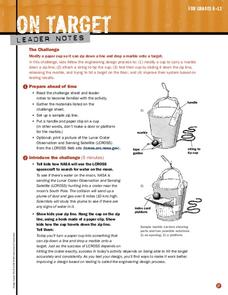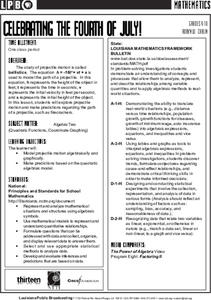Teach Engineering
Projectile Magic
What do the movies October Key and Harry Potter and the Sorcerer's Stone have in common? The fourth installment of a five-part module presents equations regarding projectile motion and how to rearrange them. Scholars view video clips...
Teach Engineering
Magical Motion
Make solutions to projectile motion problems magically appear using equations. Pupils watch a clip from a Harry Potter movie and find the length of time it takes for a remembrall to fall into Harry's hands. They use a projectile motion...
Bowels Physics
Projectile Motion
Hit a bullseye with an engaging presentation about the components of projectile motion. Viewers see how horizontal and vertical motion combine to create the parabolic path of projectile motion.
Balanced Assessment
Para-Ball-A
Analyze the flight of a thrown ball. Learners determine the maximum height of a thrown ball and the time it takes to hit the ground given its initial speed. They continue to review different scenarios with different maximums or...
Urbana School District
Projectile and Circular Motion, Torque
Introduce your young scholars to the concepts of circular motion, projectile motion, angular speed, simple harmonic motion, torque, center of mass, centripetal force, and Hooke's Law with a 86-slide presentation. The circular motion...
Teach Engineering
A Shot Under Pressure
You've got to pump it up! Using the equations for projectile motion and Bernoulli's Principle, class members calculate the water pressure in a water gun. The pupils collect data on the number of pumps and distance traveled in order...
NASA
On Target
NASA's LCROSS mission is dropping a probe into a lunar crater. Groups design a system to travel down a zip line and drop a marble onto a target in the classroom. The groups then modify their designs based upon testing.
Curated OER
Typical Numeric Questions for Physics I - Motion
Seven pages with 33 multiple choice questions about motion make up this worksheet. Calculations must be performed in order to choose the correct answer. Physics majors will solve for angles, displacement, acceleration, speed, and time...
Curated OER
Typical Numeric Questions for Physics I - Work and Energy
A total of 29 word problems furnish practice in solving for work, energy, and force. A few of the questions display diagrams to help learners visualize the systems, and all of them list five choices from which they select the correct...
Curated OER
Projectiles
Students measure the angle and distance of an arc. In this projectile lesson, students observe arcs created by water guns, bow and arrows, and slingshots, then work in small groups and use protractors and strings to measure the angle and...
Curated OER
Big Air Rules
Students discuss projectile motion using a basketball player taking off for a slam dunk, a fly ball launched off a hitter's bat, and a snowboarder flying off a pipe as examples. The lesson plan is expanded by introducing the mathematical...
Curated OER
Gravity
A summary of the science between gravity. Your students will find the resources links useful and the definition summaries relevant. This slideshow could be used to accompany a lecture or even for independent study.
Curated OER
Trajectory and Range of a Projectile
Students investigate the factors affecting projectile trajectory. In this physics lesson, students calculate the range, time and speed of projectiles using mathematical equations.
Curated OER
Parametric Projectile Motion
Learners relate projectile motion to parametric equations as they identify the velocity and angle of a projectile. They create a picture on the navigator to visualize the word problem.
Curated OER
Reel Projects
Students investigate projectile motion. In this projectile motion lesson, students investigate a website with an interactive lesson. Students view the changes in the projectile they see in the lesson. Students watch short video clips and...
Curated OER
Projectile Motion
Students determine the angle of launch that will give a projectile its greatest range. In this projectile motion lesson plan, students recognize that the motion of a projectile results from the combined horizontal and vertical...
Curated OER
Angling for Distance
Explore the concept of projectile distance through determining the angle that will provide the maximum distance of a launched projectile. Students launch baseballs on a football field and video tape the path of the ball.
Curated OER
Volcanoes are a Blast-Working with Simple Equations
In this projectile motion learning exercise, students solve 3 problems and an inquiry problem using three equations that describe projectile motion. One equation is for the maximum velocity to reach a height, H, the other is the maximum...
Curated OER
PhyzJob: Acceleration and Velocity are Entirely Different Quantities
In this acceleration and velocity activity, students are given a table to complete with position, velocity and acceleration. They draw sketched and vectors of each condition and write a verbal interpretation of the motions. They also...
Curated OER
Investigation Projectile Motion
In this science activity, students take part in an experiment that examines the motion of a projectile and measures things like velocity or direction.
Curated OER
Projectile Motion Demonstration
Students dicusss Newton's First Law of Motion. They calculate a projectile moving horizontally and vertically at different intervals. They particpate in an experiment in which the projectile is at an angle. They record and discuss the...
Curated OER
Celebrating the Fourth of July!
Young scholars model projectile motion algebraically and graphically; and make predictions based on the quadratic algebraic model.
Curated OER
Projectile Motion
Students observe projectile motion and calculate the speed of a baseball based on the time and distance traveled. They record the time, measure the distance, and draw the path of the ball's travel on a data table.
Curated OER
Cannonball
Students calculate the speed, motion and distance of a projectile. In this geometry lesson, students obtain measurements while calculating velocity. They graph their results and make predictions.

























